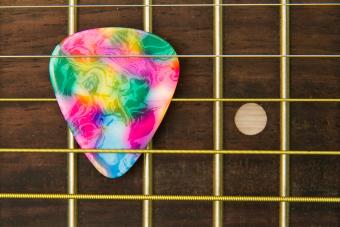
The most common use for tablature is for guitarists and bassists to learn popular tunes without having to read standard music notation. Therein lie the pros and cons of tablature as it conveys the logistics of which note or group of notes is played and on which string or strings, but it does not convey the rhythm. Tablature works best for music the student has already heard or for things like scales or arpeggios that can be played with many rhythms.
Understanding the Tablature Staff
Every guitar tab has a staff consisting of six horizontal lines that correlate with the six strings of the guitar. The tablature staff's lowest line represents the sixth string, the low E string, and the strings progress upward from that point with the A, D, G, B and high E string. This provides the basic format for a tablature staff.
E (1)---------------
B (2)---------------
G (3)---------------
D (4)---------------
A (5)---------------
E (6)---------------
Learning Tablature
To start reading tablature, the student needs a point of reference. Step one shows the six open strings of the guitar, and all three things needed to learn them: the name of the note, what it looks like in standard notation, and what it looks like in tablature, which also is where it is on the guitar. The tablature staff is the six horizontal lines depicting the strings of the guitar from 6th string low E to 1st string high E. The 0 on the string means to play the string open. The following four steps contain the basics concept of tablature and an example of everything a student can play from tablature: a scale, a single note melody and a chord progression
Step One: Learn the Open Strings
Learn and play the open strings and memorize the lines of the tablature staff.

Step Two: Learn Notes in First Position
Learn and play the notes in the first position. For facility as you learn them, increase tempo.

Step Three: Play a Simple Melody
Learn and play a simple melody using tablature. This melody is Ode to Joy from Beethoven's Ninth Symphony.

Step Four: Learn a Basic Chord Progression
Learn this basic chord progression using tablature.

The Language of Music
The language of music is vast and deep. Tablature is but one useful tool along the journey of learning this wonderful language. Use it to learn and share simple, fun musical ideas including popular tunes and riffs and even more complex concepts like scales and arpeggios for technique and improvisation.







